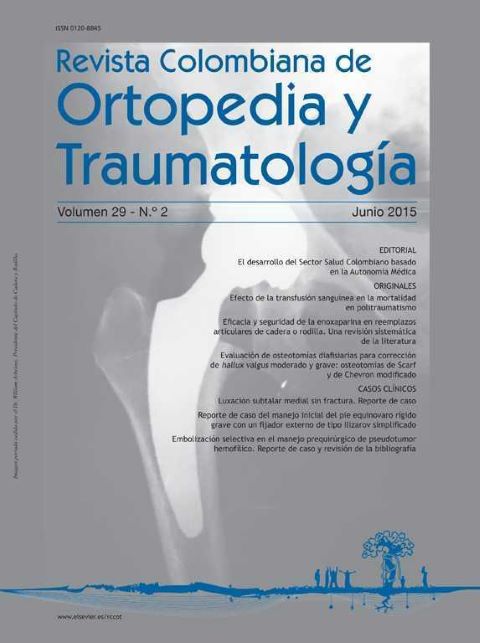Effect of blood transfusion on mortality in polytrauma
DOI:
https://doi.org/10.1016/j.rccot.2016.01.002Keywords:
multiple trauma, blood transfusion, mortalityAbstract
Introduction: Management of trauma patient is the greatest challenge in orthopaedic emergency care. Its proper diagnosis and early management, including blood transfusion, is critical for patient outcome.
Materials and methods: A prospective cohort study was conducted on all multiple injury patients between 18 and 59 years old admitted to the San José Hospital and University Children’s San José Hospital with multiple trauma (ISS > 17). They were followed-up until either discharge or death. Their demographic and clinical data were analysed in a database using descriptive statistics.
Results: A total of 97 patients were included, with mean age 38 years ± 12. The distribution multiple trauma was mild (78, 80%), moderate (12, 12%), and severe (7, 8%). All trauma patients suffered damage to limbs and pelvis, 75 (77%) closed brain trauma, 60 (61%) abdominal-pelvic, and 57 (58%) cardiovascular. Trauma causes included accidents (71, 73%), or falling from height (28, 27%). Initial haemoglobin was 12.8 g/dl ± 2.1. There were more patients admitted to ICU in the transfusion group <6 h versus >24 h (68% vs 37%), but lower mortality (0% vs 60%). The mortality in the severe multiple injuries group was 85%. As the transfusion volume received increased, so did the number of patients in ICU. Among those who died, the highest proportion received transfusion (83% vs 17%).
Conclusion: Higher mortality was found among those patients transfused and in those who
received a late transfusion.
Evidence level: II.
Downloads
References
Murray CJ, Lopez AD. Mortality by cause for eight regions of the world: Global Burden of Disease Study. Lancet. 1997;349:1269-76. https://doi.org/10.1016/S0140-6736(96)07493-4
Álvarez S. Temas de medicina general integral. Salud y Medicina. 2001;1:380.
Spahn DR, Rossaint R. Coagulopathy and blood component transfusion in trauma. Br J Anaesth. 2005;95:130-9. https://doi.org/10.1093/bja/aei169
Arias F. Transfusión autóloga en trauma. En: Ministerio de la Protección Social, editor. Guías para manejo de urgencias. Bogotá: Ministerio de la Protección Social; 2009.
Blajchman MA. Immunomodulatory effects of allogeneic blood transfusions: clinical manifestations and mechanisms. Vox Sang. 1998;74 Suppl 2:315-9. https://doi.org/10.1111/j.1423-0410.1998.tb05437.x
De Waele JJ, Vermassen FE. Coagulopathy, hypothermia and acidosis in trauma patients: the rationale for damage control surgery. Acta Chir Belg. 2002;102:313-6. https://doi.org/10.1080/00015458.2002.11679322
Bochicchio GV, Napolitano L, Joshi M, Bochicchio K, Meyer W, Scalea TM. Outcome analysis of blood product transfusion in trauma patients: a prospective, risk-adjusted study. World J Surg. 2008;32:2185-9. https://doi.org/10.1007/s00268-008-9655-0
Claridge JA, Sawyer RG, Schulman AM, McLemore EC, Young JS. Blood transfusions correlate with infections in trauma patients in a dose-dependent manner. Am Surg. 2002;68:566-72. https://doi.org/10.1177/000313480206800702
Malone DL, Dunne J, Tracy JK, Putnam AT, Scalea TM, Napolitano LM. Blood transfusion, independent of shock severity, is associated with worse outcome in trauma. J Trauma. 2003;54:898-905. https://doi.org/10.1097/01.TA.0000060261.10597.5C
Offner PJ, Moore EE, Biffl WL, Johnson JL, Silliman CC. Increased rate of infection associated with transfusion of old blood after severe injury. Arch Surg. 2002;137:711-6. https://doi.org/10.1001/archsurg.137.6.711
Gebhard F, Huber-Lang M. Polytrauma-pathophysiology and management principles. Langenbecks Arch Surg. 2008;393:825-31. https://doi.org/10.1007/s00423-008-0334-2
Huber-Wagner S, Qvick M, Mussack T, Euler E, Kay MV, Mutschler W, et al. Massive blood transfusion and outcome in 1062 polytrauma patients: a prospective study based on the Trauma Registry of the German Trauma Society. Vox Sang. 2007;92:69-78. https://doi.org/10.1111/j.1423-0410.2006.00858.x
McIntyre L, Hebert PC, Wells G, Fergusson D, Marshall J, Yetisir E, et al. Is a restrictive transfusion strategy safe for resuscitated and critically ill trauma patients. J Trauma. 2004;57:563-8. https://doi.org/10.1097/01.TA.0000136158.93864.54
Peden MMKSG. The Injury Chartbook: A graphical overview of the global burden of injuries. Geneva: World Health Organization; 2002.
Stone TJ, Riesenman PJ, Charles AG. Red blood cell transfusion within the first 24 hours of admission is associated with increased mortality in the pediatric trauma population: a retrospective cohort study. J Trauma Manag Outcomes. 2008;2, 9-2. https://doi.org/10.1186/1752-2897-2-9
Villegas MI, Morales CH, Ochoa A. Comparación del riesgo de infección del sitio operatorio en pacientes politraumatizados transfundidos con sangre autóloga vs. heteróloga. Iatreia. 2008;21 Suppl. 1:S15-6.
Trauma ACoSCo. Advanced trauma life support (ATLS(R)): the ninth edition. J Trauma Acute Care Surg. 2013; 74:1363-6. https://doi.org/10.1097/TA.0b013e31828b82f5
Castellanos A. Tratamiento del shock en el paciente traumatizado (ninos ˜ y adultos). Revista Electrónica de Medicina Intensiva. 2006;6:A36.
Cortés Buelvas A. Medicina transfusional en situaciones de trauma. Parte I. Colombia Med. 1997;28:145-56.
Cortés Buelvas A. Medicina transfusional en situaciones de trauma. Parte II. Colombia Med. 1997;28:188-204.
Del Gordo R. Trauma de extremidades en la ciudad de Santa Marta. Revista de la Facultad de Ciencias de la Salud. 2005;2:102-8.
Figueredo O. Morbimortalidad en la Unidad de Cuidados Intensivos. Revista Electronica de PortalesMedicos 2010. 2010;1(1):9-22.
Vaslef SN, Knudsen NW, Neligan PJ, Sebastian MW. Massive transfusion exceeding 50 units of blood products in trauma patients. J Trauma. 2002;53:291-5. https://doi.org/10.1097/00005373-200208000-00017
Charles A, Shaikh AA, Walters M, Huehl S, Pomerantz R. Blood transfusion is an independent predictor of mortality after blunt trauma. Am Surg. 2007;73:1-5. https://doi.org/10.1177/000313480707300101
Moore FA, Moore EE, Sauaia A. Blood transfusion. An independent risk factor for postinjury multiple organ failure. Arch Surg. 1997;132:620-4. https://doi.org/10.1001/archsurg.1997.01430300062013
Van der Linden P, De HS, Belisle S, De GF, Mathieu N, d'Eugenio S, et al. Comparative effects of red blood cell transfusion and increasing blood flow on tissue oxygenation in oxygen supply-dependent conditions. Am J Respir Crit Care Med. 2001;163:1605-8. https://doi.org/10.1164/ajrccm.163.7.2001003
Reiss RF. Hemostatic defects in massive transfusion: rapid diagnosis and management. Am J Crit Care. 2000;9:158-65. https://doi.org/10.4037/ajcc2000.9.3.158
Downloads
Published
How to Cite
Issue
Section
License
Copyright (c) 2024 Revista Colombiana de ortopedia y traumatología

This work is licensed under a Creative Commons Attribution 3.0 Unported License.

| Article metrics | |
|---|---|
| Abstract views | |
| Galley vies | |
| PDF Views | |
| HTML views | |
| Other views | |




